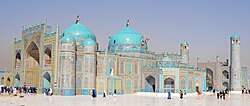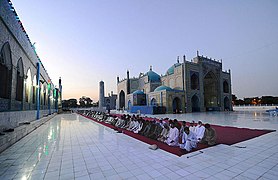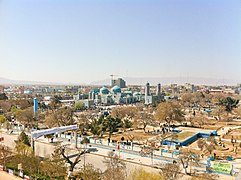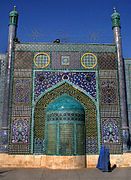Mausoleum of Imam Ali
| Shrine of Ali | |
|---|---|
مَقَام عَلِيّ | |
 The shrine as photographed in 2012 | |
| General information | |
| Type | Mausoleum |
| Location | Mazar, Afghanistan |
| Country | |
| Coordinates | 36°42′30″N 67°06′40″E / 36.70833°N 67.11111°E |
| Named for | Ali (r. 656–661) |
| Completed | c. 10th–16th century CE |
| Known for | Purported resting place of the Rashidun caliph |
The Mausoleum of Ali (Template:Lang-fa), located in Mazar-i-Sharif, Afghanistan, is a mosque which some Sufi Sunnis believe contains the tomb of ʿAlī ibn Abī Ṭālib. This site is visited particularly by Naqshbandi sufis.
Many pilgrims annually celebrate Nowruz at the site. At the annual Jahenda Bala ceremony a flag is raised in honour of Alī. People touch the flag for supposed luck in the New Year.[1][2]
History
The first structure of the site dates back to the Seljuk era. It was built by Sultan Ahmad Sanjar in the 11th century, over the grave of the Hanafi Maturidi[3] scholar and mystic, Ali ibn Abi Talib al-Balkhi.[4] He was a distant descendant of the fourth Rashidun caliph, Ali ibn Abi Talib. [5] To honour the scholar, the Sultan built the mosque and shrine complex over his grave site.
In the 13th century, the Mongols under Genghis Khan invaded Balkh, where they massacred the Balkhi population and destroyed their places of worship. The mosque built by Sanjar was destroyed by the Mongols in the year 1220.[6]
In the 15th century, the Timurid amir, Sultan Husayn Bayqara, ordered a reconstruction of the destroyed building.[7] Local legend relates that the Sultan and his assistants were digging in the area when they saw a tombstone reading "This is the grave of Asadullah Ghalib, the friend of Rasul Allah, Ali Waliullah" which the other people rejoiced upon seeing.
In later years, various rulers made repairs and endowments, including the Shaybanid emir Abdul-Mo'min bin Abdullah Khan, who built a dome. Later, Berdi Beg, the Khan of the Golden Horde who reigned from 1357 to 1359, added several decorations to the building. In the modern era, a plan was created to renovate the whole complex in 1910.[8]
Gallery
-
Muslim men praying during Ramadan, 2012.
-
Entrance to one of the buildings.
-
Distant view of the mosque in 2011.
-
White pigeons in the Blue Mosque's courtyard.
-
Close up.
-
Persian-style tile work.
-
A family feeding the pigeons
See also
References
- ^ "Janda Bala, flag raising, marked in Balkh". www.pajhwok.com. Retrieved 2020-03-28.
- ^ "Thousands celebrate Nowruz in Mazar-i-Sharif". UNAMA. 2010-03-22. Retrieved 2020-03-28.
- ^ Abu Al-Hasan Al-Balkhi and the Blue Mosque, by Dr. Dhefar Qahtan Abdul Sattar Ali Al-Hadithi. Published in Al-Rased newspaper, 1988
- ^ 'Umdat al-talib fi ansab Al 'Abi Talib. Dār Maktabat al-ḥayah, Beirut. 1964. p. 303.
- ^ 'Umdat al-talib fi ansab Al 'Abi Talib. Dār Maktabat al-ḥayah, Beirut. 1964. p. 303.
- ^ "Rowze-i Sharif | Archnet". web.archive.org. 2016-06-11. Retrieved 2023-11-12.
- ^ "Rowze-i Sharif | Archnet". web.archive.org. 2016-06-11. Retrieved 2023-11-12.
- ^ "Rowze-i Sharif | Archnet". web.archive.org. 2016-06-11. Retrieved 2023-11-12.









